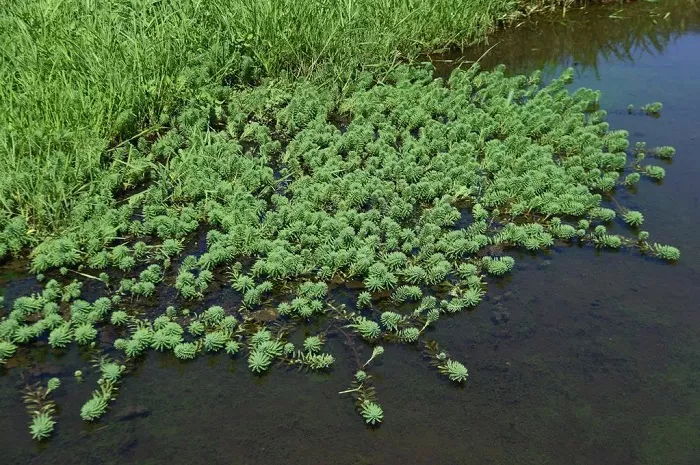As temperatures rise and garden ponds grow warmer, aquatic plants are flourishing. However, maintaining a healthy pond requires a well-balanced combination of plants. Oxygenators, such as hornwort and water buttercup, play a crucial role in keeping the water clean by absorbing nutrients. Meanwhile, floating plants like native frogbit and water soldiers provide surface cover and additional food for fish.
This week, a reader sought advice on a thick green plant that had taken over his pond, fearing it might be a weed. Upon examination, it appeared to be parrot feather (Myriophyllum aquaticum), an invasive species that is banned from sale. The recommended course of action is to remove it entirely, bag it, and dispose of it. To replace its oxygenating function, the native spiked water milfoil (Myriophyllum spicatum) is a suitable alternative. This plant thrives in slow-flowing streams, ditches, lakes, and ponds, featuring feather-like leaves and small reddish flowers that bloom on spikes in June and July.
In addition to pond plants, gardeners should consider incorporating hardy geraniums, also known as cranesbills. These herbaceous perennials are incredibly versatile and dependable, available in a wide range of shapes, sizes, and colors. Their growth habits vary from low-growing ground covers to taller, shrubby mounds, making them ideal for various garden settings, including borders and containers.
Hardy geraniums are renowned for their ease of growth, thriving in partial shade, full shade, or full sun. They require minimal maintenance, are generally pest-resistant, and attract pollinators with their delicate blooms. The color palette includes pure white, soft pinks, deep purples, and vibrant blues. In my own garden, I have seven different varieties, each adding unique beauty and functionality.
For example, Geranium macrorrhizum is a creeping pink semi-evergreen that spreads agreeably over the years. Its sticky leaves release a fresh, herbal scent when rubbed, making it an excellent choice for dry, shady spots. Another standout is ‘Ann Folkard,’ with its vivid magenta flowers and dark centers, which thrive in dry shade and complement the limey-green foliage of Alchemilla mollis.
‘Rozanne’ is a star performer, known for its large violet-blue flowers that bloom continuously from early summer to autumn. It is equally at home in borders or containers, making it perfect for patio gardens. Geranium palmatum, the Canary Island geranium, thrives in partial shade and offers fern-like foliage and soft pink flower sprays. Our native G. robertianum, or herb Robert, adds a charming touch with its spontaneous appearances and small pink blooms.
For a more dramatic display, consider G. maderense from Madeira. This tender biennial requires protection in cooler climates but produces a stunning dome of pink blooms when it flowers. ‘Mrs Kendall Clark’ is another variety worth noting, with its elegant grey-violet flowers and foliage that turns red before winter, making it an ideal companion to roses and lavender.
As summer approaches, gardeners should prioritize keeping plants, especially those in pots and containers, well-hydrated. It is also an ideal time for sowing ornamental annual flowers directly into the ground and succession sowing summer vegetables like lettuce, radish, beetroot, and spring onion for a continuous supply. Softwood cuttings can be taken from plants such as fuchsia, hydrangea, and lavender, ensuring they are cut beneath a leaf node and treated with rooting powder.
Compost heaps should be turned to aerate them and add moisture if they are too dry. Peas and beans, which are starting to flower, will need regular watering, as will carrot seedlings that require thinning. Fruit plants in pots will benefit from a high-potash liquid feed, while those in the ground can be given a sprinkle of slow-release fertilizer. Protect developing fruits from birds with netting.
In the greenhouse, ensure vents and windows are open during the day to prevent overheating, and check plants daily for watering. Dampen the floor with a hose on very hot days to increase humidity. Lilies should be staked now, and Oriental poppies, after their brief but spectacular flowering, should be cut back for a possible second flush.
Finally, harvest salads and radishes and continue sowing them in fortnightly batches. This week’s plant of the week is Stellaria holostea, also known as stitchwort. This pretty wildflower, found in hedgerows throughout summer, attracts pollinators with its white flowers and releases seeds with a popping sound when ripe.


